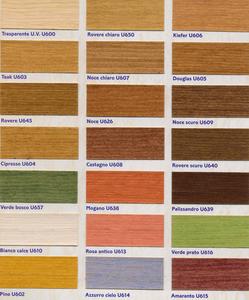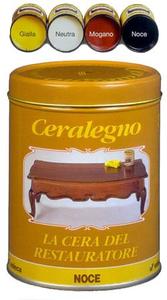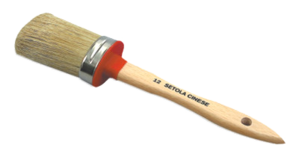
Water-based enamels
They are water-soluble and therefore non-flammable, non-toxic and water-soluble paints. They can be used on different materials, woods, metals and non-ferrous metals. They have a quick drying and guarantee a good performance over time.
Use:
Prepare the surface to be smooth and degreased.
Apply a first uniform coat and leave to dry in the shade in a dry and ventilated place without dust
Apply the following hand to cross at 90° deg. with respect to the previous hand to obtain better coverage

Impregnating
The impregnant is a protective varnish that leaves the wood surface unaltered and keeps the pores open. It is called impregnating because it penetrates into the wood fiber. Not forming a superficial film does not puff and it is not necessary to recharge for the renewal. There are transparent and colored impregnants.
Use:
- The impregnating agents must be used on perfectly dry wood surfaces
- Apply to perfectly clean and polished surfaces by mixing the product before and during use
- The application can be by brush or by dipping. Wait at least 24 hours between one hand and the next.
Transparent varnishes
The transparent "flatting" varnishes are called closed-pore varnishes because they create a shiny or opaque glass surface on the wood. If they contain pigments they can create films that change the perceived color of the wood.
Use:
- Perfectly smoothes the surface of the wood with finer sandpaper
- Spread the first coat, leave to dry for at least 48 hours and survey the surface with fine sandpaper.
- Stretch out the second hand

Wax
The waxes do not change the surface appearance of the wood but give it a silky, satin finish. There are commercially liquid or paste that are applied in thin layers with a linen cloth.
Use:
- Distribute the wax evenly the wax with a linen cloth or the brush if it is liquid wax.
- Polish the surface with a wool or sheepskin cloth.
Buffer polishing
The paint is a solution of shellac, turpentine, sandralacca and alcohol
Utitlizzo:
- Create a tampon by wrapping the cotton wool in two layers of greasy linen with a few drops of linseed oil
- Soak the swab in the paint and discharge the excess to avoid staining the surface. Do not apply at temperatures below 15 °C
- Lay it on the surface forming eight chained. Repeat the operation every 12 hours until satisfactory result.
- To obtain a perfectly polished surface and remove any residuals, repeat the operation with a cloth soaked in alcohol.
Brushes: use and maintenance
The brushes in trades have different shapes from rounded to rectangular with bristles of different types and length depending on the specific use.
For a good result it is important to use quality brushes.

Round brushes
They are used to spread the paint on irregular surfaces such as bars and profiles
Brushes with plastic band
Ideal for water-based paints or for applying vinyl glues
brushes
Those with soft bristles are suitable for applying glazes